HidroAysén
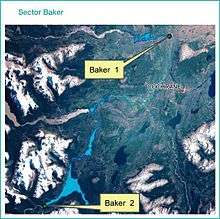
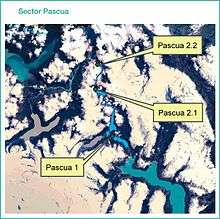
HidroAysén (Pronounced: /ˈiːdroʊ aɪˈsɛn/ EE-droh EYE-sen ![]() Audio [Spanish and English] ) is a controversial megaproject that aims to build five hydroelectric power plants in Chile's Aysén Region, two on the Baker River and three on the Pascua River (with government subvention included to help relief costs).
Audio [Spanish and English] ) is a controversial megaproject that aims to build five hydroelectric power plants in Chile's Aysén Region, two on the Baker River and three on the Pascua River (with government subvention included to help relief costs).
The dams would generate a total of 2,750 megawatts (3,690,000 hp) with further capacity for 18,430 gigawatt-hours (66,300 TJ) on average annually. The projected cost is estimated at 3.2 billion U.S. dollars (1.5 trillion Chilean pesos), making it the largest energy project in the country's history.
According to HidroAysén, the project could generate 21% Central Interconnected System's (SIC) demand by 2020.[1] A high-voltage direct current will be built between Aysén and the capital Santiago to feed the SIC and will include a submarine portion between Chaitén and Puerto Montt.
HidroAysén is owned by a corporation which is a joint venture between Endesa (a subsidiary of Italian conglomerate ENEL), with a 51% stake and by Colbún S.A. which owns the other 49%.[2]
The dams were approved on May 9, 2011 under the government of President Sebastián Piñera.[3] The decision was made by eleven counselors on a committee. Ten voted in favor, with one abstention.[4] Twenty-seven days earlier the Foreign Investment Committee was already aware of the decision ahead of time.[5] The transmission line is yet to be approved. If completed these companies would own 80% of the Chilean energy market together establishing a duopoly.[6] The project was placed on hold in early June 2012 due to protests.[7] In June 2014, the project was rejected by the government of Chile, due to calls from environmentalists.[8]
Protests
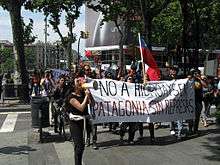
The lack of transparency in the decision making process was widely criticized by the Chilean public; In fact it elicited nationwide street protests.[9][10] The main detractors hope to initiate legal actions against the project, and have assured that the public demonstrations will be massive.[11]
The planning process has also been harshly criticized by environmentalists and the local population of the Aysén del General Carlos Ibáñez del Campo Region. According to opinion polls in April 2011, the project was opposed by 61% of the population despite a massive public relations campaign in support of it.[12] Later that same month upon government approval of the project opposition climbed to 74%.[13]
The project is opposed by Greenpeace Chile with the slogan "¡Paren el circo, No a hidroaysén!" (Stop the circus, no Hidroaysén!) and "¡Salva la Patagonia!" (Save the Patagonia!).[14] local groups show their opposition to the project with banners and bumper stickers reading, "Patagonia Sin Represas" ("Patagonia without dams").
Court case
Corporación Chile Ambiente (Chile Environmental Corporation) along with private citizens Elizabeth Schindele and Fran Yave Schindele filed a lawsuit against the megaproject based on water rights. They lost their case in the district court and later the supreme court rejected their appeal under the procedural rationale that such water rights cases cannot be appealed beyond the discretion of the lower court[15] In June 2014, the project was rejected by the Chilean government due to its alleged environmental impact, however the decision may be appealed.[8]
Proponents
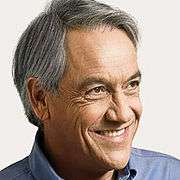
The project is supported by the business community, conservative president Sebastián Piñera, and former socialist president Ricardo Lagos who stated that the project "es necesario" (is necessary) in public comments on the issue.[16] The project is supported by 26% of the population, including 13% of self identified leftists and 41% of right wingers respectively according to Centro de Estudios, the research arm of the national La Tercera newspaper.[16] Furthermore, 19% of young people 18 to 34 years old and 34% of older people over age 55 approve of the project.[16] However, 72% of respondents believe the project will become reality.[16]
Environmental impact
The project is estimated to flood 5,900 hectares (15,000 acres) of natural reserves. It will also attract 5,000 workers from Chile and abroad. The project will be connected to the Central Interconnected System by 3,000 kilometres (1,900 mi) of electric wiring.[6]
Based on study of the project construction and access roads will impact six national parks, eleven national reserves, twenty-six conservation priority sites, sixteen wetland areas and thirty-two privately owned protected conservation areas.[6]
This is in addition to six Mapuche communities including four in Toltén and one Lautaro and Victoria.[17]
A portion of the Baker 2 dam will be located in Laguna San Rafael National Park which will cause irreversible environmental damage.[18]
-
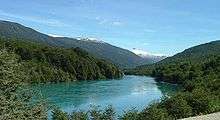
The Baker River.
-

San Rafael Lagoon is Laguna San Rafael National Park's main attraction.
Film
At the year 2010 was released the documentary 180 Degrees South: Conquerors of the Useless, which tell the journey of Jeff Johnson at the 2007 from California to the Corcovado Volcano in the Chilean Patagonia. In the film one can see a part of the manifestations of the local people, disgrunted with the project of the dams on the Baker River.
References
- ↑ "Hidroaysén" (in Spanish). Retrieved April 29, 2009.
- ↑ "HidroAysén retoma trámite ambiental y entrega adenda con respuestas" (in Spanish). Terra Colombia. April 11, 2011. Retrieved April 23, 2011.
- ↑ "Biobío Chile: Autoridades aprueban proyecto hidroeléctrico HidroAysén" (in Spanish). May 9, 2011.
- ↑ "Biobío Chile: Conoce los votos de quienes participaron en la aprobación del proyecto HidroAysén" (in Spanish). 9 May 2011.
- ↑ Biobíochile.cl (May 11, 2011). "HidroAysén: Comité de Inversiones Extranjeras anticipó hace un mes la aprobación" (in Spanish). Retrieved May 11, 2011.
- 1 2 3 Elvinculodigital.com (May 10, 2011). "Aprobado polémico megaproyecto hidroeléctrico en la Patagonia chilena" (in Spanish). Retrieved May 11, 2011.
- ↑ "Controversial dam project in Chile's Patagonia region on hold". Los Angeles Times. 1 June 2012. Retrieved 2 June 2012.
- 1 2 http://www.bbc.com/news/world-latin-america-27788286
- ↑ "Biobío Chile: Organizan diversas protestas en el país por aprobación de HidroAysén" (in Spanish). 9 May 2011.
- ↑ "Biobío Chile: Violentos incidentes se producen en las afueras del SEA luego de aprobación de HidroAysén" (in Spanish). May 9, 2011.
- ↑ "Biobío Chile: Batalla judicial anticipan detractores de HidroAysén" (in Spanish). May 10, 2011.
- ↑ "Ambientalistas destacan creciente rechazo a HidroAysén pese a enorme campaña publicitaria" (in Spanish). April 18, 2011. Retrieved April 21, 2011.
- ↑ La Tercera (May 15, 2011). "74% rechaza HidroAysén" (in Spanish). Retrieved May 16, 2011.
- ↑ ¡PAREN EL CIRCO! NO a HidroAysén. Greenpeace Chile. 6 de mayo de 2011.
- ↑ Chilean Supreme Court rejects claims of water rights in HidroAysén, ILoveChile.cl, October 27, 2011, retrieved October 30, 2011
- 1 2 3 4 Ex presidente Lagos asegura que proyecto Hidroaysén "es necesario", Terra, 15 de Mayo de 2011, retrieved 30 October 2011
- ↑ BiobíoChile.cl (11 May 2011). "Comunidades mapuche se opondrán a instalación de torres de alta tensión de Hidroaysén" (in Spanish). Retrieved 11 May 2011.
- ↑ CNN Chile (10 February 2011). "Nueva denuncia contra Hidroaysén" (in Spanish). Retrieved 12 May 2011.
External links
- News
- May, Catalina (12 May 2011). "Chile dams will bring social and environmental destruction". The Guardian.
Coordinates: 45°34′00″S 72°04′00″W / 45.5667°S 72.0667°W